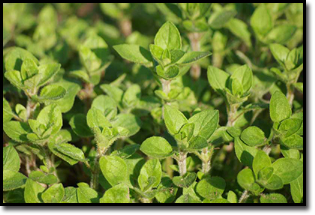
Growing Oregano
Introduction
| Oregano (Origanum Vulgare) is part of the Lamiaceae family and includes species like thyme, rosemary, sage, marjoram, oregano, hyssop and basil. |   |
The plant was native to the Mediterranean region, but widely naturalized elsewhere in the temperate Northern Hemisphere.
Types
The most common form of oregano is known as “Wild Marjoram” which comes in several varieties. The most popular strand is the Greek Oregano which is found in most homes and is often used for cooking dishes that contain tomato sauce such as spaghetti, lasagna, and pizza.
Other types include Syrian Oregano, Golden Oregano, Italian Oregano, Cuban Oregano, Mexican Oregano & Ornamental Oregano.
| Types | Image | Uses |
| Common Oregano | 
| Most households keep this in their home for its ability to flavor a wide variety of dishes. |
| Marjoram | 
| Is a less mild and spicy strand than the Greek Oregano strand. Marjoram can be used in lots of dishes and offers many great health benefits. |
| Syrian Oregano | 
| Is mostly found mixed in with a Middle Eastern spice known as “Za’atar”. |
| Golden Oregano | 
| Golden Oregano gets its name from the yellow to golden foliage that is covered in delicate pink and purple flowers, during the summer. It is edible and can be used in a wide variety of dishes. |
| Greek Oregano | 
| Greek Oregano is one of the most popular strands of oregano. It is found in most household kitchens and can be added to dozens of dishes and recipes. Most oregano plants are very easy to grow and care for. Also, with all the health benefits that oregano plants have, this really is a must-have herb to have in your garden. |
| Italian Oregano | 
| Italian Oregano is used in dozens of dishes, especially in Italian and Sicilian dishes. It can also be used for grilling vegetables and meat. Italian Oregano is the hybrid of the sweet marjoram strand and the common Greek Oregano strand and has been known to resemble both plants with its strong flavor. |
| Cuban Oregano | 
| Cuban Oregano is very strong and has thick fuzzy leaves. The flowers of this strand can be lavender, white or pink. The plants should be kept in an area, where they won’t be in direct sunlight or else they will burn and wilt. This plant can be grown indoors, and used for adding spice to Mediterranean dishes and can also be used to flavor pizzas. |
| Mexican Oregano | 
| Mexican Oregano is from a different genus than the other oregano plants but it is still quite popular in Mexican dishes (for its strong flavor and wonderful aromas). This plant thrives in a warm climate and makes a very beautiful addition to any garden. However, this strand isn’t as sturdy as other oregano plants, so it needs to be handled with care if you plan on growing it in your garden. |
| Ornamental Oregano | 
| Some strands of oregano can not be consumed but can be used for ornamental (decorative) purposes only. These plants include; Pilgrim Oregano, Amethyst Falls Oregano, Hop-Flower Oregano, Kent Beauty Oregano, Compactum Oregano and Aureum Oregano. |
Germination & Propagation
Oregano seeds are dust-like, so handle them with care. Prepare containers or plug trays using a seed starting mix, and water the soil. Then evenly distribute the tiny seeds on the surface of the soil. Similar to that of mint, seeds germinate best when exposed to sunlight and therefore do not need to be covered with any dirt. Germination occurs in 7 to 14 days.
Seeds are best stored in the refrigerator and can be purchased directly from us via our Seed Store.
To propagate oregano via cuttings, use sharp scissors and cut stems 3 to 5 inches in length. Pinch leaves and buds from the lower two-thirds of the stem but leave at least two leaves at the top of the stem. Rooting oregano plants can take place any time between spring and fall, but you’ll have more luck in spring or early summer when the stems are soft and pliable.
Then, you can simply immerse the oregano cutting in water or plant it directly into soil medium. In water, the cutting should root within about two weeks and will then be ready to transplant. Change the water daily and keep the soil medium moist.
Planting
Oregano is typically planted in the early spring. Plants in beds should be spaced approximately 12 inches apart in fairly dry soil, with full sun. Oregano will grow in just about any size pot.
It will grow in mildly acidic to strongly alkaline soil, with a preferred range being close to neutral; i.e. between 6.0 and 8.0. The Best Hawaiian Soil Mix works very well for oregano transplants.
Sun and Water
Four to eight hours of direct sunlight per day is ideal. Oregano plants prefer a hot, relatively dry climate, but also do well in other environments. Plants will grow faster with more sunlight. Water sparingly and allow the soil to dry.
Fertilizing
The fertilizer needs for oregano are almost nonexistent during the growing season if you added compost and top feed to the garden bed in the early spring. However, oregano grown in pots will need regular fertilizer boosts as the plants will quickly deplete the nutrients in the soil. Use a nitrogen dominant plant food like desert bat guano and blood meal.
Harvesting
Wait until after the morning dew has dried when harvesting oregano. The essential oils in herbs are highest in concentration in warm mornings. The best flavor is achieved when the herb is harvested before the plant starts bolting to form seeds.







